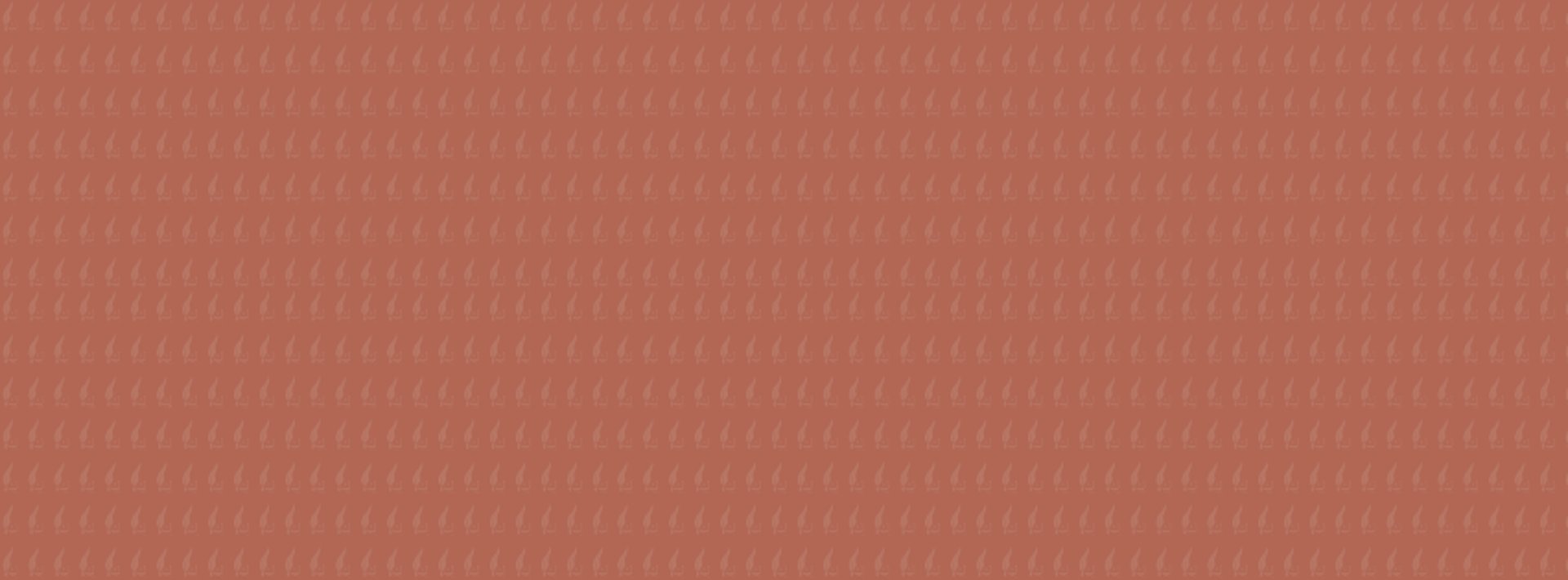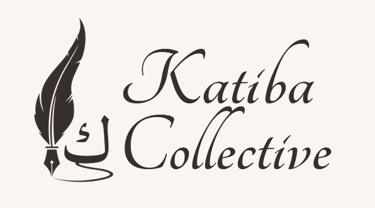UPCOMING SEMINAR: The Wife's Compass (See here)
Beyond PD & Islamic Talks
The Hollow Promise of PD & Islamic Talks
Why Teachers Deserve More
Published August 2025 by: Rahmah Ilahee
We need a revolution in how we support teachers... yesterday.
And no, regular PD (or even the most beautiful Islamic reminders) won’t save them.
This quick manifesto will help you process the knot in your chest about teaching life right now, and redirect it into a real plan that actually changes teachers from the inside out, without changing a thing on their timetable.
The uncomfortable truth: the systems “supporting” teachers are optimised for optics and compliance, not human capacity. So we give PD. We schedule a ‘bayan’ on curriculum days. Ok let's make it sound better: an Islamic keynote address. We check the box. Meanwhile, teachers are drowning, in workload and overwhelm, and the only thing that has them sitting in those talks is that the time gets included in their paychecks.
So you might be wondering two things:
1- What is this piece?
Five reality checks about Muslim teacher burnout & overwhelm: why PD won’t help, why Islamic talks won’t help, what might bridge the gap, why that solution doesn’t stand, and what the real solution is.
2- Who is it for?
Muslim school teachers who feel overworked and overwhelmed, are done with band-aids over sore teaching wounds and are ready for systems that honour the human being who teaches.
Reality Check #1: Why Regular PD Won’t Help
On paper PD is tidy and logical: you have a problem in the classroom → we give you training → you fix it. Struggling with behaviour? PD. Want more engaging lessons? PD. Feeling drained? PD. The message is simple and seductive: learn more, do better, feel better.
That promise works as a selling point because it sounds fair. It assumes teachers are like tools: if they’re not performing, they need an upgrade. But the assumption is the problem.
But you know how it actually is:
You finish school at 4pm, eat with one eye on the inbox, mark until 10pm, and sleep badly because tomorrow’s lesson depends on tonight’s prep.
You carry home school decisions that affect your family time, because the system expects your labour to stretch beyond the timetable.
You show up to a day-long PD, leave with a binder, a few buzzwords that felt good for two hours… and a tighter pit of "I should be doing more."
Monday arrives. The same timetable, the same yard duty, the same three new emails. The PD content is evaporated by survival. The problem was never “not enough strategies.” It was no capacity to use them.
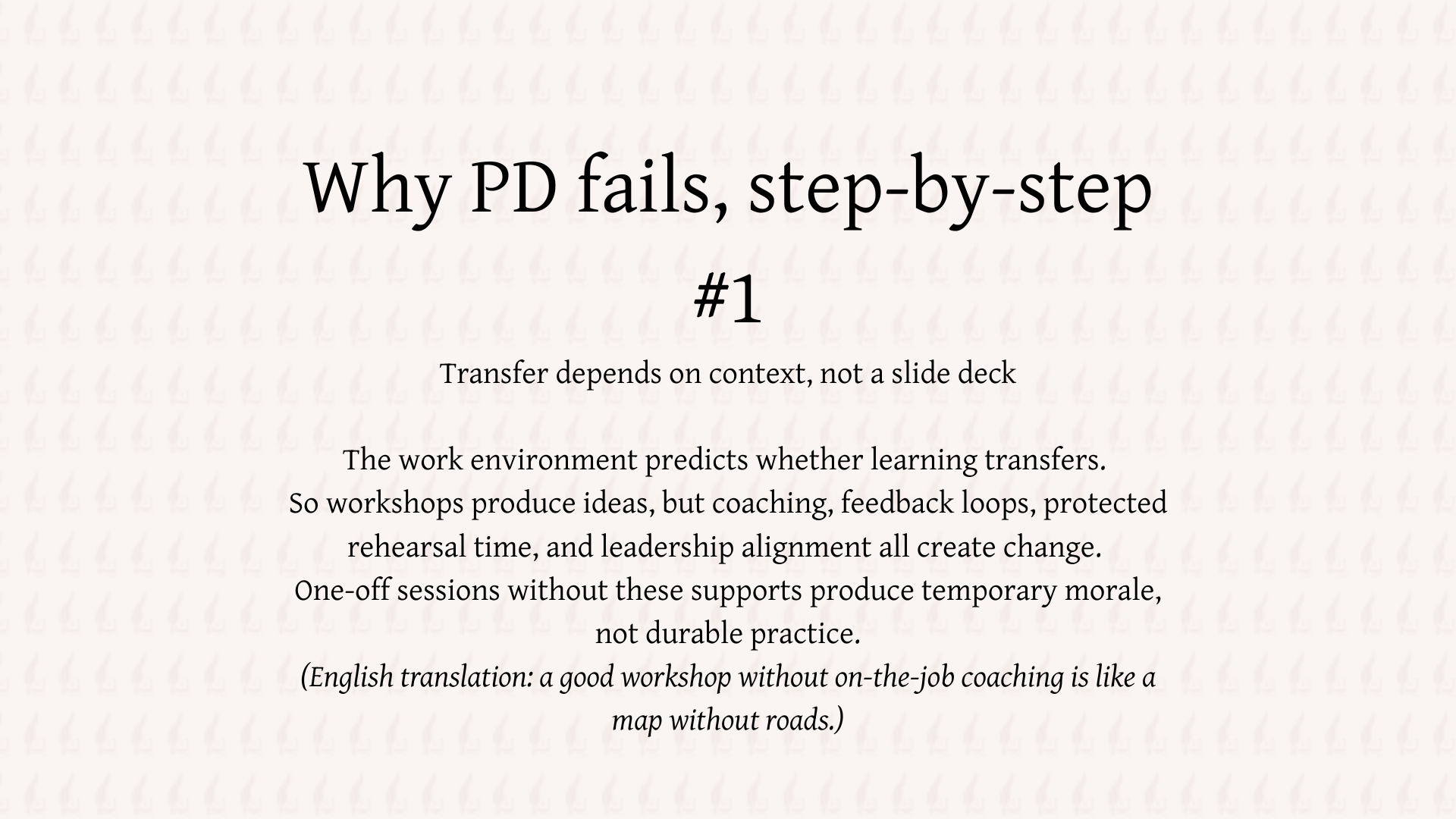
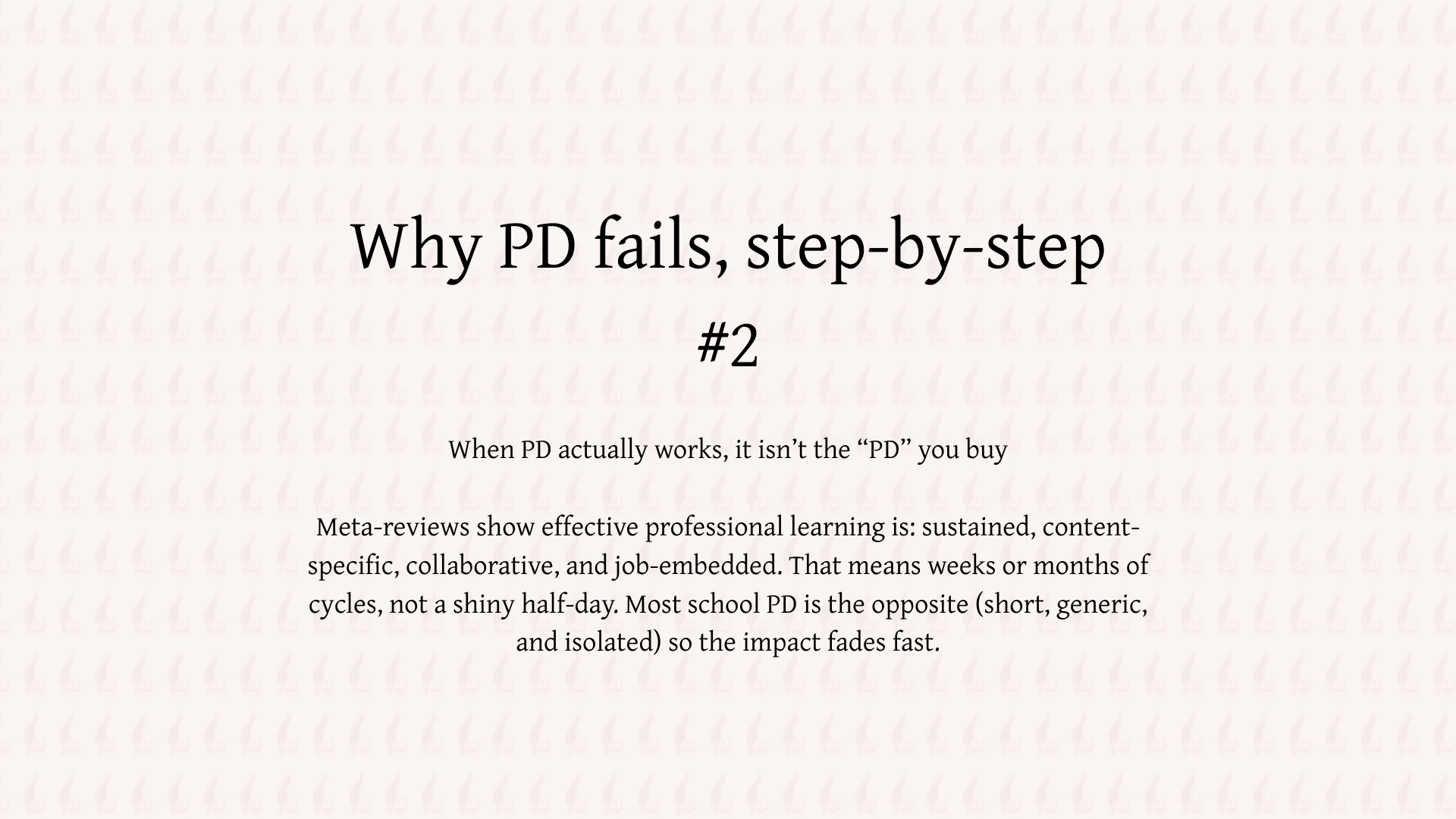
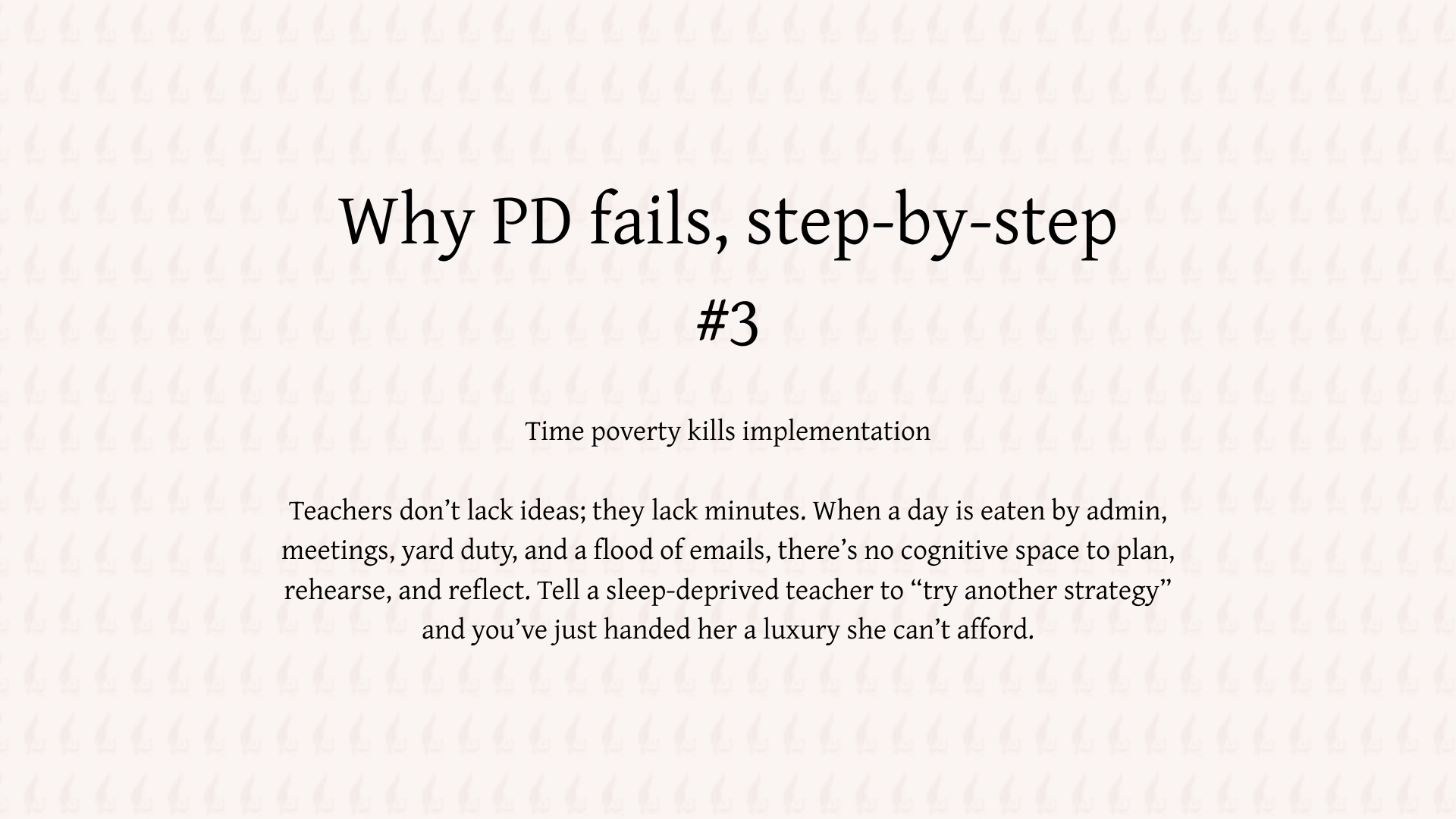
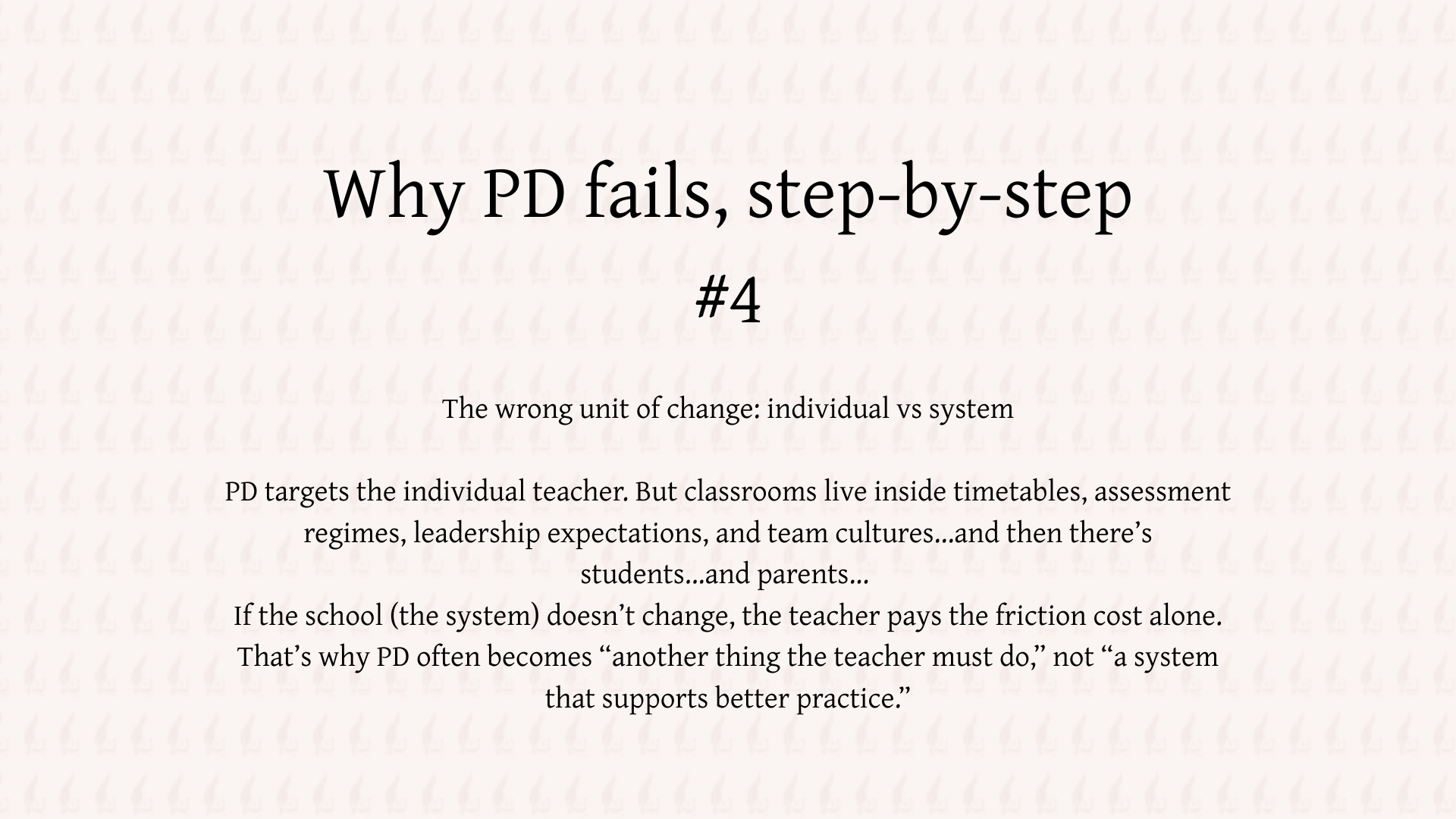
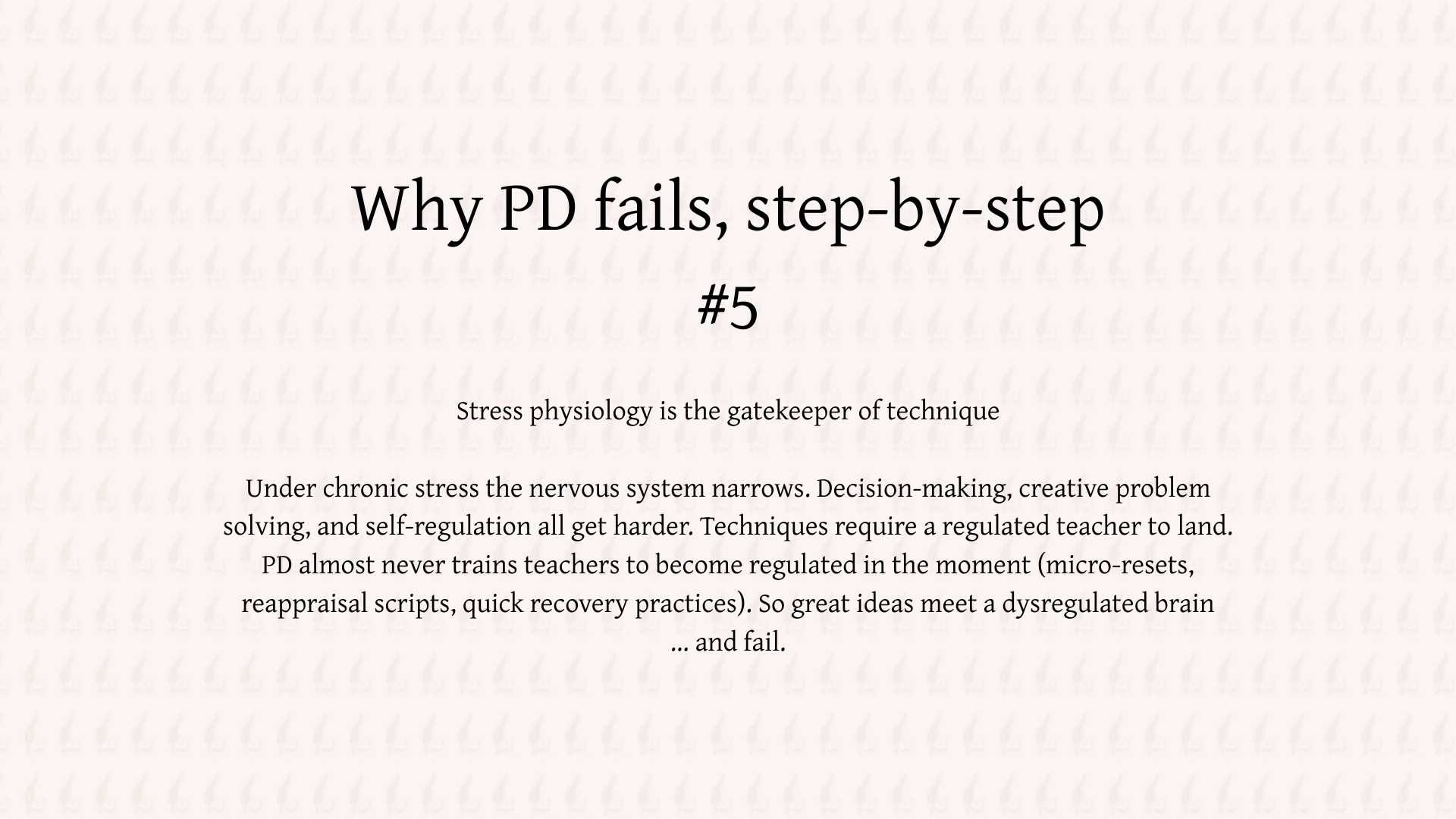
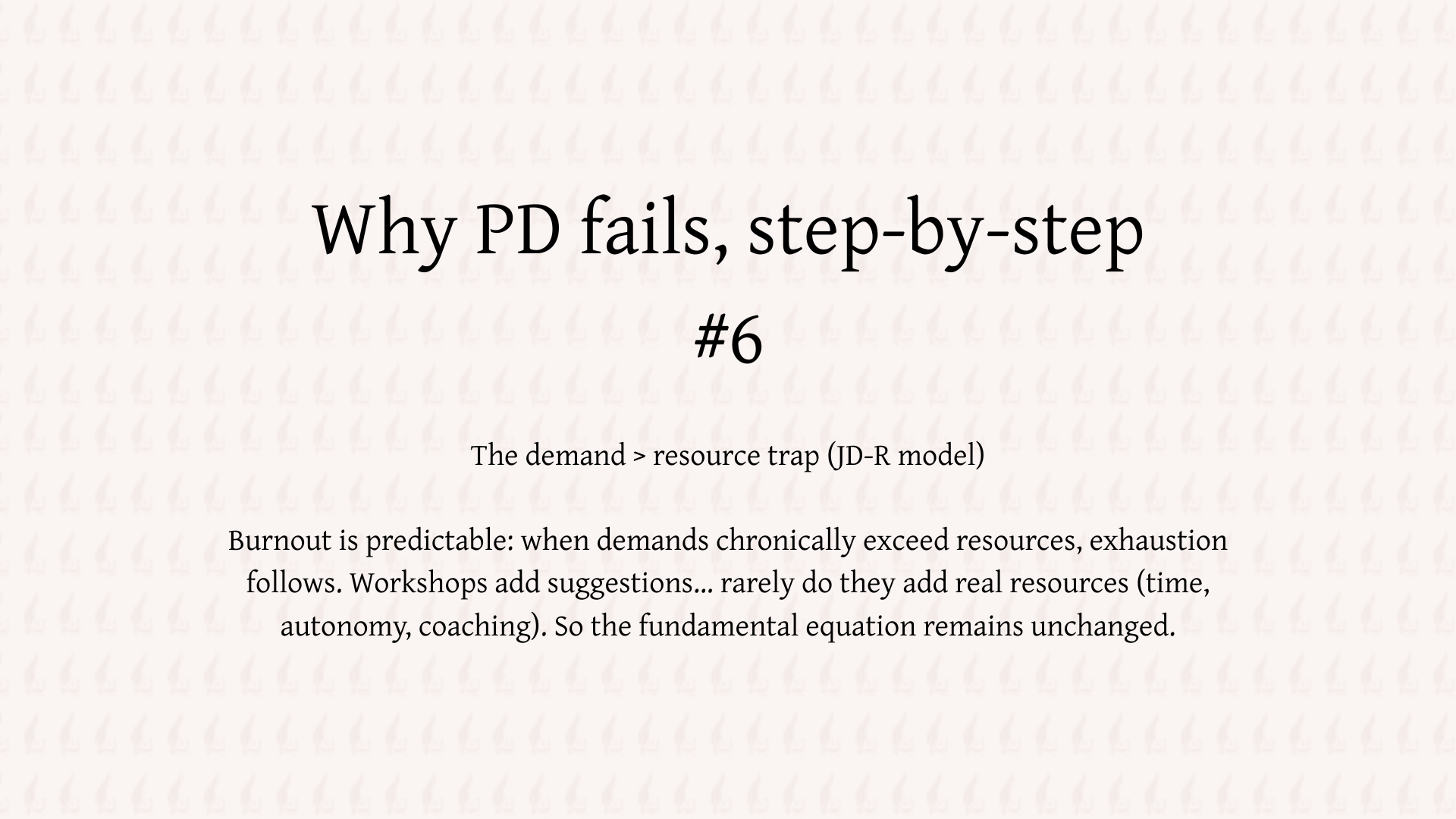
These are the findings that should make any school teacher (or leader) pause:
One-off PD rarely transfers into classroom practice; transfer depends on workplace supports (coaching, leadership, feedback).
Effective PD is sustained, content-focused, collaborative, and iterative (NOT a single afternoon).
Coaching (personalised cycles) produces materially larger gains in instruction and measurable student benefit than sit-and-get training.
Teachers are chronically time-poor; you cannot PD your way out of structural time poverty.
The Job Demands-Resources (JD-R) model explains burnout: without added resources, added expectations only push people toward exhaustion.
(You may already know these lines from soundbite studies, but hearing them together clarifies that the problem isn’t random; it’s predictable and fixable in a non-theatrical way.)
Probable conclusion #1 (just hold onto it for now):
If the culture, timetable, and supports stay the same, PD hands you a prettier binder and a heavier heart. Strategies don’t fail because teachers are lazy or incompetent.
They fail because the conditions do. Capacity doesn’t rise by telling people to be better; it rises when systems actually give people the time, support, and context to be better.
Reality Check #2: Why Islamic Talks Won’t Help
When teachers feel drained, communities instinctively turn to what feels safe: a spiritual reminder.
A lecture about the virtue of knowledge.
A hadith about the reward of patience.
A verse about intentions being weighed by Allah.
And it is comforting. No one denies that these reminders soften the heart and re-orient us to Allah. They are like a sip of cool water after a long day.
But a sip of water is not the same as a hydration plan. And for exhausted teachers, that’s the difference between relief and renewal.
Imagine an overworked teacher:
She’s behind on marking.
Senior leadership keeps piling on new admin.
Tomorrow’s lesson feels more like firefighting than teaching.
One Friday evening, she drags herself to a local masjid lecture. The imam reminds her: “The best of you are those who teach others good.” He shares stories of scholars who persevered with sabr. Her heart softens. She feels seen. For a moment, she breathes easier.
But then she goes home. The pile of books is still on her desk. The admin emails keep pinging. Monday looms ahead. The talk gave her spiritual uplift, but no tools for the grind.
Here’s the compassionate truth:
Inspiration without integration breeds guilt. A spiritual high doesn’t dismantle systemic exhaustion.
Yes, research confirms that spiritual well-being can buffer against burnout. Yes, prayer and dhikr soothe stress. But correlation is not a plan.
A fiery lecture does not:
Restructure workloads.
Build classroom systems.
Train leadership to model balance.
Create peer cultures of support.
So you walk away feeling you are the problem: “If I really had sabr, I wouldn’t feel like this.” Instead of relief, you sink deeper into shame.
This is where well-meaning reminders can backfire: sabr doesn’t erase systemic exhaustion, tawakkul doesn’t replace boundary-setting or workflow skills, and barakah loves structure, but barakah cannot bless chaos (no pun intended).
When Islamic talks present spirituality as the only remedy, teachers internalise blame for conditions they didn’t create. And that is not justice.
Probable conclusion #2 (again hold onto this as we move along):
Spiritual reminders are necessary, but not sufficient. Teachers need:
Frameworks to translate 'intention' into practice.
Skills to align 'sabr' with professional boundaries.
Systems where 'barakah' can flourish.
Leadership support that integrates values into policy.
Inspiration opens the heart.
But only integration transforms the profession.
Reality Check #3: What ‘Actually’ Moves the Needle
After talking about PD and Islamic talks, it might feel like we’re at a dead end.
“If training doesn’t fix it and inspiration doesn’t fix it… then what does?”
The promise here is simple: there is a way to bridge the gap between overwhelm and capacity. But it’s not about another workshop or another lecture. It’s about building an ecosystem that actually meets teachers where they are, emotionally, cognitively, and structurally.
Teachers are humans first, professionals second. Their exhaustion is not a personal flaw, rather it’s a predictable outcome of systems that demand more than they can safely give.
Strategies fail if the timetable leaves no room to implement them.
Motivation fades if leadership and colleagues aren’t aligned.
Spiritual reminders feel hollow if stress is chronic and unregulated.
The mechanism is always the same: demand > resource. PD gives knowledge. Talks give purpose. Neither adds real capacity.
What Might Work: The Multi-Layered Approach
Structural Alignment: Timetables, workloads, admin tasks, and leadership expectations must be calibrated to reality; teachers need protected time for planning, marking, and recovery.
Sustained, Job-Embedded Support: Iterative coaching cycles, collaborative problem-solving, and embedded skill application are essential.
Capacity for Emotional and Cognitive Regulation: Teachers need practical tools for stress regulation, nervous-system recovery, and boundary-setting...and that too with techniques that land in the workday, not just in a weekend lecture or evening reflection.
Integration of Values and Meaning: Spiritual and ethical motivation must connect to actionable routines.
Not a Single Solution but an Ecosystem: structural supports + practical skill-building + resilience practices + meaning integration = thriving teachers.
Alone, each element is necessary but insufficient. Together, they address the full human experience of teaching.
The solution is not another binder or another talk. It’s an ecosystem that gives teachers:
a) time to breathe.
b) space to apply skills.
c) support to regulate themselves.
d) context to live their values without guilt.
When that ecosystem exists, teachers don’t just survive, they thrive. The difference between burnout and flourishing isn’t effort. It’s conditions, integration, and capacity.
Reality Check #4: The Comfort Trap of the “Ecosystem”
Look, let’s be honest. When you read #3, it sounds so good, doesn’t it? Systems aligned, coaching in place, resilience practices, workflows integrated, meaning connected. It feels holistic. It feels like a solution.
But that feeling? That’s exactly the problem.
The ecosystem frame is intellectual theatre.
It looks like progress because it has structure, layers, and logic.
Of course it does; it’s processed and ideated by the human mind, a mind that wears whatever borrowed glasses we hand it. Glasses we put on unthinkingly, never considering the consequences. Glasses that stop at the limits of human knowledge: experiential, intellectual… revelational? Not yet.
The perfectly structured, logical “ecosystem”? Yes. The solution? No.
You can polish every process, optimise every schedule, run every PD cycle flawlessly… and she will still feel overworked, overwhelmed, and unseen.
Think of it this way:
You can give her all the PD, all the coaching, all the workflow redesigns.
You can preach sabr, embed meaning, restructure admin.
And she can still feel burnt out, because the internal frame - the lens from which she interprets her work, her purpose, and herself - hasn’t changed colour.
The ecosystem can hold her, but it cannot create her capacity.
So, we need to change the colour of her lens, give her a better pair of glasses (insert any creative metaphor of choice here), you get the idea.
Here’s the uncomfortable truth:
We’ve been trying to solve external problems with external solutions because it feels actionable. But capacity doesn’t emerge from timetables or binders. It emerges from within her.
There’s a level of insight, alignment, and internal integration - call it revelational knowledge - that no system, workflow, or talk can deliver. It’s the kind of knowing that reshapes perception, recalibrates priorities, and turns exhaustion into discernment instead of despair.
Until the teacher’s inner frame shifts, everything else is window-dressing. The “holistic ecosystem” will feel like a beautiful theory while she burns out in practice.
In essence:
PD is dead.
Long live the Identity Shift.
If you thought the "ecosystem" was the answer, you were enjoying a comforting delusion. Systems, coaching, resilience workshops…they’re all simply enablers. Real transformation starts deeper: in the teacher herself, in how she perceives, integrates, and carries her work in alignment with her values and purpose.
Here’s the kicker: the moment you call it PD, you’ve already framed it as someone else’s responsibility. The internal dialogue - that she may even deny to herself at times - sounds something like:
“The school provides it, I just attend.”
“It’s scheduled into my workday; the school pays for it; they’ll handle it.”
“I’m a passive recipient, not an active agent.”
Paradoxically, this disempowers the very person who should be in the driver’s seat. The teacher is the driver of her teaching, but by framing growth as a school-funded PD, she’s expected to sit in the passenger seat, comply, and hope for change.
True agency disappears.
This is why schools must not fund it.
Because the shift is internal, not structural. Paying for it risks turning it into “another session to attend,” reinforcing passivity and a helpless mindset towards their real classroom and staffroom challenges. True transformation must come from within: she must initiate it, wrestle with it, and own it.
The ecosystem (the aligned schedules, coaching, resilience practices, etc.) serves only as a container, not a generator. The teacher herself is the generator of her own capacity. Miss that, and all your carefully layered frameworks, however polished and holistic, are just noise.
Reality Check #5: The Identity Shift
The real solution starts here: an internal ecosystem built on heartwork, mind, and practice. Each pillar matters, none can be skipped.
1. Heartwork
This is the reservoir of intention, emotional capacity, and resilience. Heartwork nurtures patience, clarity of purpose, and the quiet discipline that keeps her grounded. This is the internal calibration that allows teaching to feel fulfilling all the time.
2. Belief work
The mind is the lens through which she interprets challenges, structures knowledge, and integrates understanding into action. It’s the reflective, discerning part of the teacher that asks: Why does this matter? What does this mean? How does this connect with the truth I believe in? Mindwork shapes perspective, decision-making, and judgment. It ensures her responses are aligned with principles rather than reactive survival.
3. Practice
Practice is where the heart & mind become action. Practice is the place where internal alignment meets external reality, and where teaching becomes Muslim, in the physical world (without her having to teach Islam).
Is There a Fourth?
No. There cannot be a fourth, even theoretically. If you accept the Truth of Revelation, the internal ecosystem of heart, mind, and practice is complete. The hadith of Jibril makes this clear: belief (Iman), practice (Islam), and excellence (Ihsan) in conduct are the cornerstone of a Muslim identity. Heart, mind, and practice -- cornerstone complete.
Anything else (PD, workshops, coaching, Islamic inspiration) can support, but it cannot generate the core from outside. The Identity Shift is entirely internal, self-owned, and self-sustaining.
The Identity Shift is not optional. Not nice-to-have. Not a “let’s see if I get around to it.” It is the core of sustainable teaching.
Here’s the unvarnished truth:
capacity doesn’t come from anyone else. Not PD, not lectures, not leadership support. It comes from the teacher herself: her heart, her mind, her practice. She must take responsibility, engage intentionally, and integrate this work into her daily life.
This is the internal ecosystem that sustains teaching when life is relentless. It’s what allows a teacher to carry meaning, resilience, and purpose alongside every lesson, every student, every challenge.
If a school recognises this, it could amplify the shift - embedding a year-long program, intentional weekly reflection, or structured growth into the school rhythm.
But let’s be clear: the Identity Shift is still her responsibility.
The school can support, but it cannot generate the internal capacity. That work is hers, and hers alone.
The brutal yet empowering (or brutally empowering - whichever way you take it) takeaway
The Identity Shift is non-negotiable, rare, and hard. Either life hits her with a moment so stark she cannot ignore this truth any longer...or she commits to long-term, sustained, intentional internal work (not necessarily time-consuming or high-performance at all, but consistent, yes).
No system, no talk, no workshop can do this for her. The teacher must own it, drive it, and integrate it. Everything else is secondary.
If this manifesto shifted something in you, and you'd like to understand this concept more, you can watch this free 60-minute on-demand Masterclass going over this Identity Shift idea in a slightly different way:
More Than 'Just' A Teacher
See you there.
If this is the solution, why don’t more teachers do it? Because it’s hard. Real hard.
1) Sometimes, life forces the shift. A sudden trauma, a crisis, a moment of deep failure or loss shakes the body, mind, and heart, leaving no choice but to rethink everything. A phoenix-moment.
2) Other times, it requires slow, (some read that as: boring) sustained work. Day by day, week by week, drip-fed into the teacher’s life. This is the kind of intentional identity development that might take a year or more: subtle, consistent, repetitive, utterly internal. No shortcuts. No instant fixes. No half-day attendance ticked off.
Either way, the teacher must face reality: there is no easy path. This is why it’s rare, why it’s overlooked, and why teachers continue burning out despite PD, workshops, or inspirational talks.


